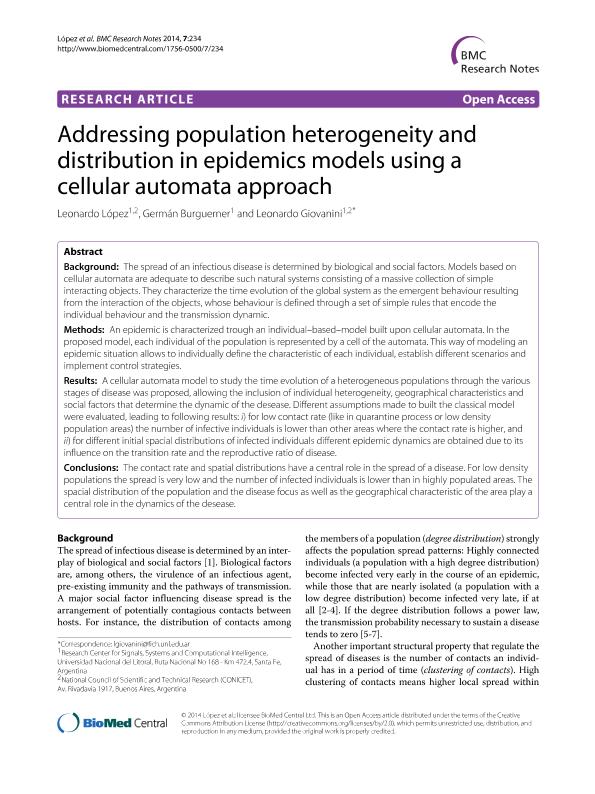Mostrar el registro sencillo del ítem
dc.contributor.author
López, Leonardo Rafael

dc.contributor.author
Burguerner, Germán
dc.contributor.author
Giovanini, Leonardo Luis

dc.date.available
2017-04-26T18:45:38Z
dc.date.issued
2014-02
dc.identifier.citation
López, Leonardo Rafael; Burguerner, Germán; Giovanini, Leonardo Luis; Addressing population heterogeneity and distribution in epidemics models using a cellular automata approach; Biomedical Central; BMC Research Notes; 7; 2-2014; 234-245
dc.identifier.issn
1756-0500
dc.identifier.uri
http://hdl.handle.net/11336/15751
dc.description.abstract
BACKGROUND: The spread of an infectious disease is determined by biological and social factors. Models based on cellular automata are adequate to describe such natural systems consisting of a massive collection of simple interacting objects. They characterize the time evolution of the global system as the emergent behaviour resulting from the interaction of the objects, whose behaviour is defined through a set of simple rules that encode the individual behaviour and the transmission dynamic. METHODS: An epidemic is characterized trough an individual–based–model built upon cellular automata. In the proposed model, each individual of the population is represented by a cell of the automata. This way of modeling an epidemic situation allows to individually define the characteristic of each individual, establish different scenarios and implement control strategies. RESULTS: A cellular automata model to study the time evolution of a heterogeneous populations through the various stages of disease was proposed, allowing the inclusion of individual heterogeneity, geographical characteristics and social factors that determine the dynamic of the desease. Different assumptions made to built the classical model were evaluated, leading to following results: i) for low contact rate (like in quarantine process or low density population areas) the number of infective individuals is lower than other areas where the contact rate is higher, and ii) for different initial spacial distributions of infected individuals different epidemic dynamics are obtained due to its influence on the transition rate and the reproductive ratio of disease. CONCLUSIONS: The contact rate and spatial distributions have a central role in the spread of a disease. For low density populations the spread is very low and the number of infected individuals is lower than in highly populated areas. The spacial distribution of the population and the disease focus as well as the geographical characteristic of the area play a central role in the dynamics of the desease
dc.format
application/pdf
dc.language.iso
eng
dc.publisher
Biomedical Central
dc.rights
info:eu-repo/semantics/openAccess
dc.rights.uri
https://creativecommons.org/licenses/by-nc-sa/2.5/ar/
dc.subject
Cellular Automata
dc.subject
Epidemy
dc.subject
Population Heterogenity
dc.subject
Public Health
dc.subject.classification
Ciencias de la Información y Bioinformática

dc.subject.classification
Ciencias de la Computación e Información

dc.subject.classification
CIENCIAS NATURALES Y EXACTAS

dc.title
Addressing population heterogeneity and distribution in epidemics models using a cellular automata approach
dc.type
info:eu-repo/semantics/article
dc.type
info:ar-repo/semantics/artículo
dc.type
info:eu-repo/semantics/publishedVersion
dc.date.updated
2017-04-17T19:26:35Z
dc.journal.volume
7
dc.journal.pagination
234-245
dc.journal.pais
Reino Unido

dc.description.fil
Fil: López, Leonardo Rafael. Consejo Nacional de Investigaciones Científicas y Técnicas. Centro Científico Tecnológico Conicet - Santa Fe. Instituto de Investigación En Señales, Sistemas E Inteligencia Computacional. Universidad Nacional del Litoral. Facultad de Ingeniería y Ciencias Hidricas. Instituto de Investigación En Señales, Sistemas E Inteligencia Computacional; Argentina
dc.description.fil
Fil: Burguerner, Germán. Consejo Nacional de Investigaciones Científicas y Técnicas. Centro Científico Tecnológico Conicet - Santa Fe. Instituto de Investigación En Señales, Sistemas E Inteligencia Computacional. Universidad Nacional del Litoral. Facultad de Ingeniería y Ciencias Hidricas. Instituto de Investigación En Señales, Sistemas E Inteligencia Computacional; Argentina
dc.description.fil
Fil: Giovanini, Leonardo Luis. Consejo Nacional de Investigaciones Científicas y Técnicas. Centro Científico Tecnológico Conicet - Santa Fe. Instituto de Investigación En Señales, Sistemas E Inteligencia Computacional. Universidad Nacional del Litoral. Facultad de Ingeniería y Ciencias Hidricas. Instituto de Investigación En Señales, Sistemas E Inteligencia Computacional; Argentina
dc.journal.title
BMC Research Notes
dc.relation.alternativeid
info:eu-repo/semantics/altIdentifier/url/https://bmcresnotes.biomedcentral.com/articles/10.1186/1756-0500-7-234
dc.relation.alternativeid
info:eu-repo/semantics/altIdentifier/doi/http://dx.doi.org/10.1186/1756-0500-7-234
Archivos asociados
